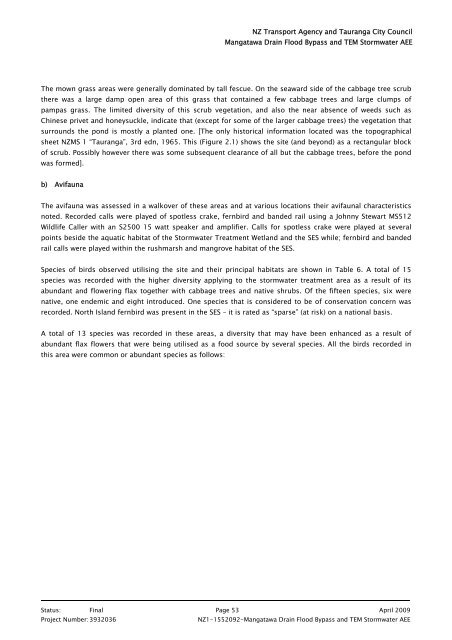2. Mangatawa catchment consents for earthworks, storm water ...
2. Mangatawa catchment consents for earthworks, storm water ...
2. Mangatawa catchment consents for earthworks, storm water ...
- No tags were found...
You also want an ePaper? Increase the reach of your titles
YUMPU automatically turns print PDFs into web optimized ePapers that Google loves.
NZ Transport Agency and Tauranga City Council<br />
<strong>Mangatawa</strong> Drain Flood Bypass and TEM Storm<strong>water</strong> AEE<br />
The mown grass areas were generally dominated by tall fescue. On the seaward side of the cabbage tree scrub<br />
there was a large damp open area of this grass that contained a few cabbage trees and large clumps of<br />
pampas grass. The limited diversity of this scrub vegetation, and also the near absence of weeds such as<br />
Chinese privet and honeysuckle, indicate that (except <strong>for</strong> some of the larger cabbage trees) the vegetation that<br />
surrounds the pond is mostly a planted one. [The only historical in<strong>for</strong>mation located was the topographical<br />
sheet NZMS 1 “Tauranga”, 3rd edn, 1965. This (Figure <strong>2.</strong>1) shows the site (and beyond) as a rectangular block<br />
of scrub. Possibly however there was some subsequent clearance of all but the cabbage trees, be<strong>for</strong>e the pond<br />
was <strong>for</strong>med].<br />
b) Avifauna<br />
The avifauna was assessed in a walkover of these areas and at various locations their avifaunal characteristics<br />
noted. Recorded calls were played of spotless crake, fernbird and banded rail using a Johnny Stewart MS512<br />
Wildlife Caller with an S2500 15 watt speaker and amplifier. Calls <strong>for</strong> spotless crake were played at several<br />
points beside the aquatic habitat of the Storm<strong>water</strong> Treatment Wetland and the SES while; fernbird and banded<br />
rail calls were played within the rushmarsh and mangrove habitat of the SES.<br />
Species of birds observed utilising the site and their principal habitats are shown in Table 6. A total of 15<br />
species was recorded with the higher diversity applying to the <strong>storm</strong><strong>water</strong> treatment area as a result of its<br />
abundant and flowering flax together with cabbage trees and native shrubs. Of the fifteen species, six were<br />
native, one endemic and eight introduced. One species that is considered to be of conservation concern was<br />
recorded. North Island fernbird was present in the SES – it is rated as “sparse” (at risk) on a national basis.<br />
A total of 13 species was recorded in these areas, a diversity that may have been enhanced as a result of<br />
abundant flax flowers that were being utilised as a food source by several species. All the birds recorded in<br />
this area were common or abundant species as follows:<br />
Status: Final Page 53 April 2009<br />
Project Number: 3932036<br />
NZ1-1552092-<strong>Mangatawa</strong> Drain Flood Bypass and TEM Storm<strong>water</strong> AEE
















